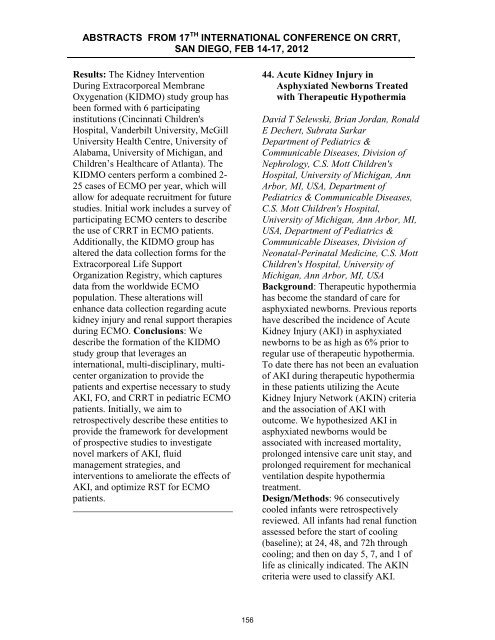ABSTRACTS from 16th International COnference on ... - CRRT Online
ABSTRACTS from 16th International COnference on ... - CRRT Online
ABSTRACTS from 16th International COnference on ... - CRRT Online
You also want an ePaper? Increase the reach of your titles
YUMPU automatically turns print PDFs into web optimized ePapers that Google loves.
<str<strong>on</strong>g>ABSTRACTS</str<strong>on</strong>g> FROM 17 TH INTERNATIONAL CONFERENCE ON <strong>CRRT</strong>,<br />
SAN DIEGO, FEB 14-17, 2012<br />
Results: The Kidney Interventi<strong>on</strong><br />
During Extracorporeal Membrane<br />
Oxygenati<strong>on</strong> (KIDMO) study group has<br />
been formed with 6 participating<br />
instituti<strong>on</strong>s (Cincinnati Children's<br />
Hospital, Vanderbilt University, McGill<br />
University Health Centre, University of<br />
Alabama, University of Michigan, and<br />
Children’s Healthcare of Atlanta). The<br />
KIDMO centers perform a combined 2-<br />
25 cases of ECMO per year, which will<br />
allow for adequate recruitment for future<br />
studies. Initial work includes a survey of<br />
participating ECMO centers to describe<br />
the use of <strong>CRRT</strong> in ECMO patients.<br />
Additi<strong>on</strong>ally, the KIDMO group has<br />
altered the data collecti<strong>on</strong> forms for the<br />
Extracorporeal Life Support<br />
Organizati<strong>on</strong> Registry, which captures<br />
data <str<strong>on</strong>g>from</str<strong>on</strong>g> the worldwide ECMO<br />
populati<strong>on</strong>. These alterati<strong>on</strong>s will<br />
enhance data collecti<strong>on</strong> regarding acute<br />
kidney injury and renal support therapies<br />
during ECMO. C<strong>on</strong>clusi<strong>on</strong>s: We<br />
describe the formati<strong>on</strong> of the KIDMO<br />
study group that leverages an<br />
internati<strong>on</strong>al, multi-disciplinary, multicenter<br />
organizati<strong>on</strong> to provide the<br />
patients and expertise necessary to study<br />
AKI, FO, and <strong>CRRT</strong> in pediatric ECMO<br />
patients. Initially, we aim to<br />
retrospectively describe these entities to<br />
provide the framework for development<br />
of prospective studies to investigate<br />
novel markers of AKI, fluid<br />
management strategies, and<br />
interventi<strong>on</strong>s to ameliorate the effects of<br />
AKI, and optimize RST for ECMO<br />
patients.<br />
44. Acute Kidney Injury in<br />
Asphyxiated Newborns Treated<br />
with Therapeutic Hypothermia<br />
David T Selewski, Brian Jordan, R<strong>on</strong>ald<br />
E Dechert, Subrata Sarkar<br />
Department of Pediatrics &<br />
Communicable Diseases, Divisi<strong>on</strong> of<br />
Nephrology, C.S. Mott Children's<br />
Hospital, University of Michigan, Ann<br />
Arbor, MI, USA, Department of<br />
Pediatrics & Communicable Diseases,<br />
C.S. Mott Children's Hospital,<br />
University of Michigan, Ann Arbor, MI,<br />
USA, Department of Pediatrics &<br />
Communicable Diseases, Divisi<strong>on</strong> of<br />
Ne<strong>on</strong>atal-Perinatal Medicine, C.S. Mott<br />
Children's Hospital, University of<br />
Michigan, Ann Arbor, MI, USA<br />
Background: Therapeutic hypothermia<br />
has become the standard of care for<br />
asphyxiated newborns. Previous reports<br />
have described the incidence of Acute<br />
Kidney Injury (AKI) in asphyxiated<br />
newborns to be as high as 6% prior to<br />
regular use of therapeutic hypothermia.<br />
To date there has not been an evaluati<strong>on</strong><br />
of AKI during therapeutic hypothermia<br />
in these patients utilizing the Acute<br />
Kidney Injury Network (AKIN) criteria<br />
and the associati<strong>on</strong> of AKI with<br />
outcome. We hypothesized AKI in<br />
asphyxiated newborns would be<br />
associated with increased mortality,<br />
prol<strong>on</strong>ged intensive care unit stay, and<br />
prol<strong>on</strong>ged requirement for mechanical<br />
ventilati<strong>on</strong> despite hypothermia<br />
treatment.<br />
Design/Methods: 96 c<strong>on</strong>secutively<br />
cooled infants were retrospectively<br />
reviewed. All infants had renal functi<strong>on</strong><br />
assessed before the start of cooling<br />
(baseline); at 24, 48, and 72h through<br />
cooling; and then <strong>on</strong> day 5, 7, and 1 of<br />
life as clinically indicated. The AKIN<br />
criteria were used to classify AKI.<br />
156
















